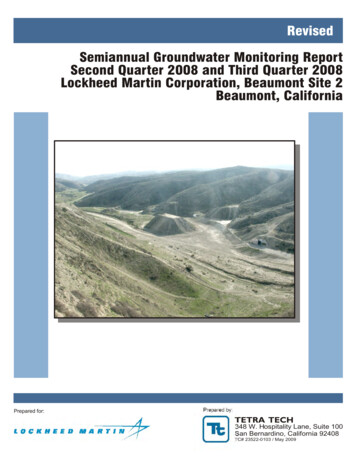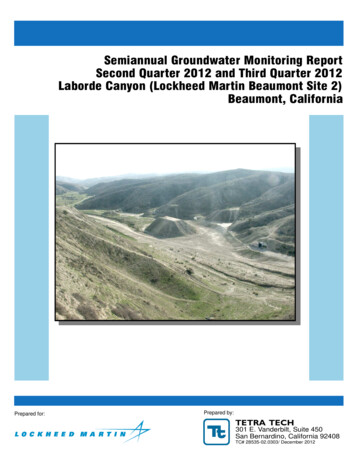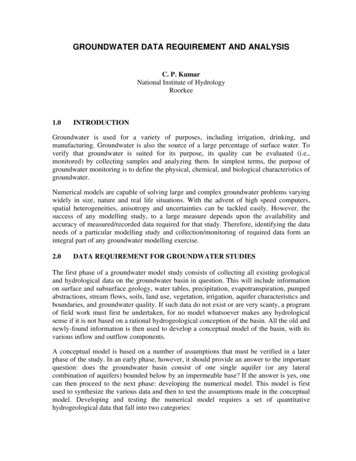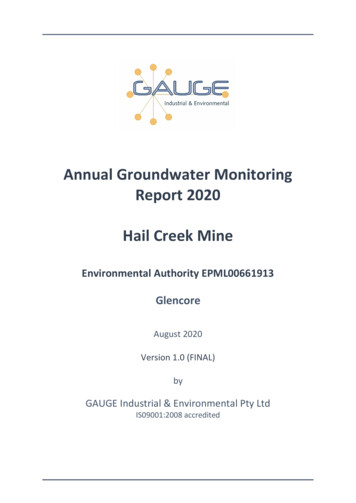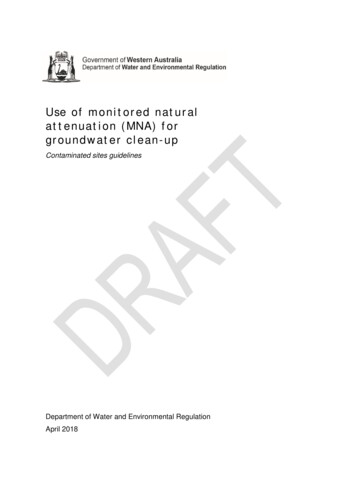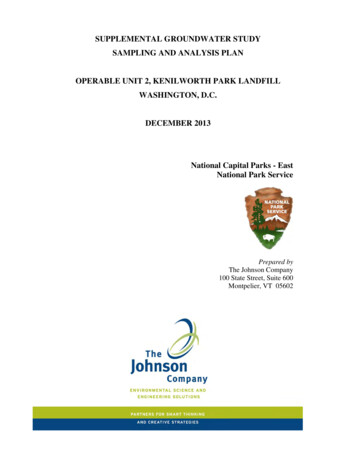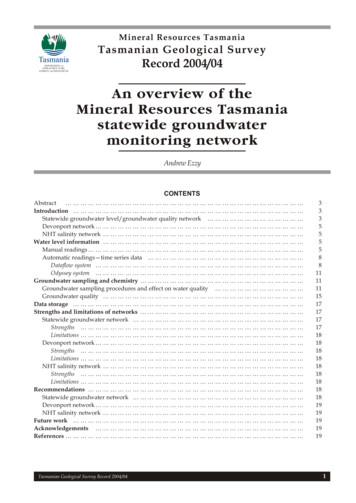
Transcription
1st Quarter 2013OWRB Initiates Groundwater Monitoring andAssessment Program (GMAP)OWRB InitiatesGroundwater Monitoringand Assessment Program(GMAP)With approximately 386 million acre-feet of groundwater in storage, Oklahoma’s aquifers provideenormous benefits to agriculture, industry, drinking water suppliers, and other users.Interest in the formal assessment of Oklahoma’s groundwater resources began with groundwaterlevel data collection in the 1950s, and it continued with allocation studies in the early 1970s andan attempt to characterize ambient groundwater quality conditions in the late 1980s. For morethan four decades, the OWRB has directed an annual winter (January-March) well measurementprogram, used to relate changes in groundwater levels in some areas of the state with departuresOWRB Approves New Rules from normal (mean) precipitation levels.for Oversight of Water fromThis information has been extremely useful but somewhat limited in scope. Most groundwaterMines2013 Water AppreciationDay: Water for 2060quality monitoring activities have focused on compliance with specific regulations. Historically,overall funding for groundwater studies has been limited. In general, insufficient data exists today(continued on page 3)ISF Advisory GroupReconvenesDean Couch RetiresDrought UpdateFour-year implementation schedulefor GMAP water quality and waterlevel monitoring in Oklahoma’s 22 majoraquifers.While last year’s unprecedented passage of water legislation providesreassurance that Oklahoma is on a constructive path toward a more securewater future, this current session has been much more subdued from awater perspective. As always, OWRB staff are assisting our lawmakers asthey address constantly evolving water issues, especially in light of a thirdstraight year of statewide drought.Notable bills filed early on referenced such topics as individual droughtrelief funding for farmers, ranchers and other rural citizens, establishmentof regional water planning groups, wastewater reuse, and expanded WaterBoard membership and representation. Some of these ideas were included(continued on page 2)
2 Oklahoma Water NewsFrom the Director (continued)in priority and supporting initiatives identified in the 2012Update of the Oklahoma Comprehensive Water Plan anddeserve attention.The OWRB continues working with the Legislature tofoster measures that protect and improve Oklahoma’swater resources, especially the Water for 2060 Act, whichwas sponsored last session by House Speaker Kris Steeleand passed with bipartisan support. This forward-thinkinglegislation arose from one of the Water Plan’s mostfundamental grassroots suggestions in recommending waterusage levels and conservation measures for the next halfcentury. The Act establishes a statewide conservation goal,a funding mechanism for pilot conservation projects, andan advisory council to contemplate incentives and othermeasures that have promise in reducing Oklahoma’s waterfootprint. Conservation, our cheapest source of water,remains Oklahoma’s most viable and accessible planningstrategy to avoid inevitable water deficits.“We must all resist the tendency to accept the lastseveral decades of plentiful water resources as “normal”and become lackadaisical—at precisely the wrong time ifhistory is any indication—in planning for an inevitableand perhaps just as lengthy period of dryness.”A commitment to conservation, along with dependableinfrastructure, is our best defense against drought. By now,we should all be familiar with the extreme variability ofOklahoma’s precipitation, both geographically and on anannual basis. What better example is there than this ongoingdrought episode, which comes right on the heels of thelongest sustained period ofstatewide precipitation inmore than a century? Wemust all resist the tendency toaccept these last few decadesof plentiful water resourcesas “normal” and becomelackadaisical—at precisely thewrong time if history is anyindication—in planning for aninevitable and perhaps just aslengthy period of dryness.On a related note, the OCWPInstream Flow Workgroupreconvened on March 1. Youmay recall that the groupwas originally commissionedduring the OCWP updateprocess to conduct anindependent technical,legal, and policy analysisof a potential instream flowprogram in Oklahoma. At this1st Quarter, 2013As drought conditions continue across the state, OWRB staff haveresponded to increasing numbers of inquiries from water users,concerned citizens, legislators, the media and others about dwindlingwater supplies. OWRB Hydrologist Maria Moreno shares informationon the drought, conservation and planning with Telemundo (Spanishlanguage network) reporter Carlos Ortiz during a recent interview onthe shores of Lake Hefner in Oklahoma City.initial meeting, we had very beneficial discussion concerningthe development of recommendations that effectively balancethe water needs of consumptive users with those relying uponwater in our streams and lakes for economic developmentand recreation.Finally, I want to thank everyone who participated inour annual Water Appreciation Day at the State Capitolon March 19. Each year, this popular event serves toremind Oklahomans that dozens of state and federal waterorganizations are constantly working on their behalf andimproving the management and protection of Oklahoma’sinvaluable water resources. I am personally reminded eachWater Day how proud I am to lead a key agency in thisworthwhile endeavor. SThis graph, updated to include 2012 data, plainly demonstrates Oklahoma’s often dramatic wet and dry cycles,which frequently confound state water users and planners alike. Since modern climatological record-keepingbegan in the 1890s, the state has seen five major multi-year, regional drought events. These occurred in the late1890s, from 1909-18, 1930-40, 1952-58 and, to a lesser extent, 1962-72. It is interesting to note that each ofthese episodes contained at least one year of above-normal rainfall.
Oklahoma Water News 3GMAP Initiated (continued)to manage and protect groundwater resourcesadequately in the majority of the state’s majoraquifers.In 2012, due to a priority recommendation of theOklahoma Comprehensive Water Plan (OCWP), theOklahoma Legislature and Governor recognized theimportance of Oklahoma’s groundwater resources.Concerns about groundwater susceptibility todepletion and pollution were legitimized throughappropriation of funding to initiate Oklahoma’sfirst holistic, long-term, aquifer-based GroundwaterMonitoring and Assessment Program (GMAP). GMAPwill examine the ambient quality and quantity ofOklahoma’s groundwater resources to identify areasthat are impaired and improve understanding of theeffects of seasonal and climatic usage patterns. Thisdata will aid water resource planners and managersin making informed decisions that ultimately result in Hydrograph of an OWRB Mass Measurement Program well near El Reno shows 36years of water level data (red line). Average annual precipitation for the Centralimproved sustainability of water supplies.OK Climate Region is also plotted (source: OK Climatological Survey). GMAP willThrough both baseline surveillance and long-termsignificantly increase the number and distribution of wells monitored for water leveland add a water quality data collection component to allow for much improved ability(trend) monitoring networks, GMAP will provideinformation on individual aquifers as well as general to analyze the state’s groundwater resources.information at a regional and statewide level. By 2016, staffused for continuous monitoring and evaluated multiple timeswill complete a general characterization of water levels andper year to facilitate characterization of seasonal changes; ageochemistry of all major aquifers. The aquifers will then beselect number of wells will be equipped with water level dataplaced on a five-year sampling schedule. A minimum of 30loggers to monitor changes on the scale of weeks, days, andwells per aquifer will be monitored for water quality and ateven hours.least 40 additional wells monitored for water levels. Watersamples will be analyzed for parameters such as nutrients,Data collected through GMAP will be made available to thedissolved metals, alkalinity, hardness, dissolved oxygen, pH,public in a variety of formats through the OWRB’s website atand total dissolved solids. A sub-set of these wells will bewww.owrb.ok.gov/gmap. SOWRB Approves New Rules for Oversight of Water from MinesOn February 19 the OWRB adopted new rules to implement provisions of SB 597, regulating use of groundwater trappedin a producing mine pit that emanates from a sensitive sole source groundwater basin. This decision was precededby more than 20 stakeholder meetings during two years, a formal public hearing process, and several modifications inresponse to comments.The Oklahoma Legislature passed SB 288 in 2003, establishing specific rules for withdrawal of groundwater in sensitivesole source basins. As a result, conflict and litigation arose regarding provisions of the Oklahoma Groundwater Law thatexempted the “taking, use, or disposal of water trapped in producing mines” from water permit requirements. In 2010,meetings were held with stakeholders, including the Citizens for the Protection of Arbuckle-Simpson Aquifer, OklahomaAggregates Association, National Park Service, Chickasaw and Choctaw Nations, and various cities and miningcompanies.In 2011, SB 597 placed new monitoring, management, and reporting requirements on mining operations that take, use,or dispose of water trapped in producing mines. The OWRB was directed to adopt implementation rules to meet theserequirements. Additional stakeholder meetings were then held to address SB 597 directives, OWRB authority underagency rules, and technical criteria.For more than a year, the OWRB continued working with stakeholders to provide a path for existing mining companies toremain exempt from groundwater permitting and regulation if they are able to demonstrate that they are not over-taxingvulnerable groundwater supplies. Since rule adoption, several mining operations have exhibited a willingness to work withOWRB staff in developing their water management plans and initiating monitoring and reporting of activities.The new statute and subsequent agency rule essentially evens the playing field between mining companies, whoseoperations may dewater aquifers, and other state water users, such as public water suppliers, who are required to obtaina permit to withdraw groundwater. It also results in increased drinking water reliability, specifically for residents in theArbuckle-Simpson region, and in added protection for the Chickasaw National Recreation Area. S1st Quarter, 2013
4 Oklahoma Water News2013 Water Appreciation DayThe eighth annual Water Appreciation Day washeld on March 19 at the State Capitol. Dozensof state, federal, tribal, and local governmentalagencies, as well as private organizations,showcased their various water programs andrelated educational efforts, many of whichsupport “Water for 2060” measures for efficiency,conservation, recycling, and reuse.The cThe cheapest and mostwide range of innovativavailable to solidify OkoWater ReuseAs part of a larger wastewater treatmentplant upgrade, Guymon Utilities Authorityimplemented a land application systemto dispose of greywater.2013 Water Appreciation Day ParticipantsAlan Plummer Associates, Inc.American Farmers and RanchersC. H. Guernsey & Co.Canton Lake AssociationCarollo EngineersChickasaw Nation/Choctaw NationCitizens for the Protection of the Arbuckle-Simpson AquiferFinancial Assistance Program (OWRB)Oklahoma Aggregates AssociationOklahoma Climatological SurveyOklahoma Conservation CommissionOklahoma Department of Environmental QualityOklahoma Department of MinesConserving Indoors Repair dripping faucets, toilets, and other leaks. Turn off the tap while shaving or brushing teeth. Use a stopper in the sink when washing dishes. Do not use running water to thaw food. Make sure the dishwasher is fully loaded. Add food wastes to your compost pile instead ofusing the garbage disposal. Wash only full loads of laundry or use thewashing machine’s load size selection.Water ReuseHennessey Publadded a greywasystem as part olagoon expansioLeak RepairThe El Reno Municipal Authorityreplaced leaking water lines throthe city to increase efficiency.Automated Meter ReLawton Water Authority instautomated meter reading (Awhich allows them to identifleaks more effectively whileefficiency.Oklahoma Environmental Services, Inc.Oklahoma Floodplain Managers AssociationOklahoma Geological SurveyOklahoma Municipal LeagueConserving OutdoorsOklahoma Rural Water Association Sweep driveways and sidewalks rather than using a hose. Water in the early morning (4 to 7 a.m.) to reduce evaporation. Adjust sprinklers to water the lawn, not the house, sidewalk, or street. Do not over water. If you step on your lawn and the grass springs back, it doesnot require water. Check your garden hose for leaks and a tight connection to the spigot. Wash the car with water from a bucket, or consider using a commercial carwash that recycles water. Reduce the amount of turf grass in your yard by xeriscaping or usingnative and drought-tolerant plants that require less water.Oklahoma Scenic Rivers CommissionOklahoma Water LawOklahoma Water SurveyOklahoma Water Resources Center (OSU)Oklahomans for Responsible Water PolicyOWRB Monitoring and StudiesSave The Illinois RiverTulsa District, US Army Corps of EngineersUS Bureau of ReclamationWater for 2060 (OWRB)1st Quarter, 2013
Oklahoma Water News 5cheapest source of water isCONSERVATION.Visit the OWRB’sWater for 2060 web page:t accessible source of water is conservation. “Water for 2060” represents ave conservation measures, incentives, and related project financing optionsklahoma’s water future and minimize deficits projected by the 2012 Updateof the Oklahoma Comprehensive Water Plan (OCWP).www.owrb.ok.gov/conservationStreambank StabilizationThe Oklahoma ConservationCommission and Oklahoma StateUniversity partnered on a streambankstabilization project on Cow Creek.Among other benefits, restoring streamsto their natural state reduces sedimentloading and enhances water quality,leading to improved water supplies.Educating CitizensOklahoma City has produced a seriesof creative water conservation publicservice announcements. Educationis an important and often overlookedconservation tool.Green InfrastructureBixby Public Works Authority hasembraced low-impact developmentinnovations through the installation ofrain gardens and permeable pavement toimprove drainage and reduce wastewatertreatment costs.eWater Reuse: just look forthe purple water lines.lic Works Authorityater land applicationof the community’s recenton project.Water ReuseGaillardia, a golf course community,has been irrigating with reclaimed watersince 1996. This alternative to usingpotable water from Oklahoma City isalso utilized by two electrical utilities.Collectively, these reuse programs savemore than 1 billion gallons of drinkingwater annually.youghoutRainwater HarvestingA modest OWRB Water ConservationGrant allowed Tahlequah High Schoolto capture rainwater and store it in a6,000-gallon cistern for use in wateringthe area’s landscape.Green RoofsIncentivesAt OU’s National Weather Center, avegetative roof system (green roof)reduces stormwater runoff, improveswater quality, and reduces thebuilding’s energy demands.eadingtalled anAMR) system,fy and repaire increasing Leak DetectionGrady County Rural Water District #6has reduced system leakage by 25percent by replacing old valves andmeters and installing a new automatedmeter reading system, along withimproved management techniques.Water ProvidersThe best way to ensure good conservation is to have a well-managed system and one that takesadvantage of eligible funding through the OWRB Financial Assistance Program. The CWSRFand DWSRF loan programs are helping Oklahoma meet Water for 2060 goals today.Tax benefitsLow-interest loansCost-sharingTiered water pricingInnovative Measures High efficiency plumbing codesLeak detection and preventionEducation programsGreen infrastructureWater recycling/reuseControl of invasive speciesUse of marginal quality waters1st Quarter, 2013
6 Oklahoma Water NewsISF Advisory Group ReconvenesThe OCWP Instream Flow (ISF) Advisory Group, created in2009 as a workgroup to address instream flow issues for theOklahoma Comprehensive Water Plan (OCWP), reconvenedon March 1 in Oklahoma City to continue deliberatinghow an instream flow program might be implemented inOklahoma. Following the directive of an OCWP “priorityrecommendation” for ISFs, the first facilitated workshopwas intended to implement the process developed by theAdvisory Group to ascertain the suitability and structure of anISF program.The primary focus of the Group is to determine if andhow Oklahoma—both legally and practically—can ensureprotection for specific amounts of water in a river or streamthat are integral to downstream environmental, social, andeconomic benefits. Early in 2011, the Advisory Grouprecommended the following process related to creation of apotential instream flow program: (1) address legal and policyquestions; (2) study other mechanisms for protecting instreamflows; (3) develop a draft methodology for instream flowstudies; (4) conduct a study of economic impacts of instreamflows; (5) perform an instream flow pilot study in a scenicriver; and (6) preserve the instream flow workgroup.Facilitated by consultants from CH2MHill and CarolloEngineering through funding from the Corps of Engineers,the Advisory Group made its initial attempt to implementthis process at the March meeting. Prior to the meeting,members were asked to contribute responses to the followingdiscussion topics/questions: What are the most significant potential consequencesof an instream flow program in Oklahoma? How could any negative consequences be mitigated? What are the potential consequences of notimplementing an instream flow program? What other approaches could be taken to mitigatethose consequences? How could we measure the social and environmentalconsequences of an instream flow program? How could we measure the financial impacts of aninstream flow program? How could a pilot project be used to evaluate andmeasure your benefits and concerns? Should an instream flow program be measured bypotential economic impacts alone? If an instream flow program is developed, whatwould be the most important aspects for the programto protect or enhance? Should legal/regulatory protections be provided forthose with existing consumptive water rights? Howcould those protections be provided?Many responses focused on how a specific mechanismto protect instream flows might affect current and futurewater rights and availability for consumptive users. Severalmembers emphasized the complexity of the issue, fromboth a legal and technical aspect, pointing out that any ISFprogram would likely require statutory changes.The Group cited dozens of additional issues and impacts thatmust be addressed and mitigated prior to ISF implementation,including creation of “artificial shortages” for consumptiveusers, perception of wasting water by allowing more toflow out of state, reduced water availability for economicdevelopment, and impacts on current uses of reservoirs.Among potential benefits of ISF program implementation,members listed protection of the health of ecosystems andstreams, increased biodiversity, reduced endangered speciesissues, maintenance and enhancement of recreational andtourism opportunities and associated economic benefits,maintenance of adequate flows for wastewater discharges,more reliable lake levels, and increased ability to meetcurrent permit needs.ISF Advisory Group members will continue discussions andactivities aimed at fostering a better understanding of thiscomplicated and, at times controversial, issue at their nextworkgroup meeting scheduled for May 16, 2013. SDean Couch RetiresAfter 30 years of state service, including 27 years asGeneral Counsel, Dean Couch retired from the OWRBon January 31. One of Oklahoma’s most respectedauthorities on state water law, Couch represented theOWRB in countless important cases, including casesin the U.S. Supreme Court. Couch provided esteemedlegal interpretation and scholarly advice to dozens ofBoard members, OWRB staff, and members of theState Legislature.Veteran staff attorney Jerry Barnett will temporarilyoversee the Office of the General Counsel as theOWRB continues to address a number of lawsuitsinvolving the management and protection ofOklahoma’s water resources. S1st Quarter, 2013Dean Couch (third from right) at his final board meeting in January.Pictured left to right are Board members Jason Hitch and Ed Fite, ExecutiveDirector J.D. Strong, Board Chairman Ford Drummond, and Boardmembers Rudy Herrmann, Linda Lambert, Tom Buchanan, Marilyn Feaver,and Richard Sevenoaks.
Oklahoma Water News 7Drought UpdateU.S. Drought MonitorApril 2, 2013Drought Intensity & Percentof State in Drought CategoryReservoir StorageApril 1, 2013Abnormally Dry100.00Moderate Drought100.00Severe Drought83.07Extreme Drought53.07Exceptional Drought9.90Streamflow (7-Day Average)April 1, 2013HydrologicDrought LevelBelow NormalModerateSevereExtremeKeetch-Byram Drought IndexApril 1, 2013Percent of Normal PrecipitationLast 90 Days (January 1 to March 31)PercentData obtained from the National Drought Mitigation Center, U.S. Geological Survey, U.S. Army Corps ofEngineers and Oklahoma Climatological Survey. For more drought information, and to obtain updatedinformation on Oklahoma’s drought and moisture conditions, go to www.owrb.ok.gov/drought.1st Quarter, 2013
Oklahoma Water NewsSTANDARD PRESORTEDU.S. POSTAGEOklahoma Water Resources Board3800 N. Classen Blvd.Oklahoma City, OK 73118PAIDOklahoma City, OKPermit No. 310www.owrb.ok.govFord Drummond, Chairman Linda Lambert, Vice Chairman Tom Buchanan, SecretaryBob Drake Ed Fite Marilyn Feaver Rudy Herrmann Jason Hitch Richard SevenoaksProtecting and enhancing the quality of life for Oklahomans by managing and improving the state’s waterresources to ensure clean and reliable water supplies, a strong economy, and a safe and healthy environment.Financial Assistance Program UpdateLoans & Grants Approved as of April 1, 20131st Quarter 2013Darla Whitley, EditorStaff Writers:Brian Vance & Darla WhitleyPhotography:Barry FogertyE-mail comments, questions,or article submissions topubinfo@owrb.ok.govor call us at (405) 530-8800.FAP Loans—355 for 874,360,000Emergency Grants—566 for 33,776,351The OWRB’s Financial Assistance Program (FAP), createdby the State Legislature in 1979, provides loans for waterand wastewater system improvements in Oklahoma. Thetremendous popularity of the bond loan program is due, in part,to extended payoff periods of up to 30 years at very competitiveinterest rates, averaging approximately 4.762 percent since1986.Emergency grants, limited to 100,000, are awarded to correctsituations constituting a threat to life, health, or property andare an indispensable component of the agency’s financialassistance strategy.CWSRF Loans—266 for 1,167,985,974The Clean Water State Revolving Fund (CWSRF) loan programwas created in 1988 to provide a renewable financing sourcefor communities to use for their wastewater infrastructureneeds. The CWSRF program is Oklahoma’s largest selfsupporting wastewater financing effort, providing low-interestloans to communities in need.DWSRF Loans—159 for 846,908,300The Drinking Water State Revolving Fund (DWSRF) loanprogram is an initiative of the OWRB and OklahomaDepartment of Environmental Quality to assist municipalitiesand rural water districts in the construction and improvement ofdrinking water systems. These projects are often mandated forcommunities to obtain compliance with increasingly stringentfederal standards related to the treatment of drinking water.REAP Grants—585 for 51,969,016The Oklahoma Water News is published by theOklahoma Water Resources Board as authorizedby J.D. Strong, Executive Director. Eighty-eighthundred copies have been printed by UniversityPrinting Services at an approximate cost of 32cents each. Copies have been deposited at thePublications Clearinghouse of the OklahomaDepartment of Libraries.The Rural Economic Action Plan (REAP) Program was createdby the State Legislature in 1996. REAP grants, used for water/wastewater system improvements, target primarily ruralcommunities with populations of 7,000 or less, but priority isafforded to those with fewer than 1,750 inhabitants.Drought Response Program Grants—7 totaling 490,791Through the OWRB’s Drought Response Program, fundingis available for communities in most dire need during statedrought emergencies declared by the Governor. A maximumof 300,000 is diverted from existing OWRB Emergency Grantfunds to establish the Program.Total Loans/Grants: 1,938 for 2,975,490,432Estimated Savings: 1,022,001,366Applicants eligible for water/wastewater project financialassistance vary according to the specific program’s purposeand requirements, but include towns and other municipalitieswith proper legal authority, various districts establishedunder Title 82 of Oklahoma Statutes (rural water, master/water conservancy, rural sewage, and irrigation districts),counties, public works authorities, and/or school districts.Applications for agency financial assistance programs areevaluated individually by agency staff. Those meeting specificprogram requirements are recommended by staff for approvalat monthly meetings of the nine-member Water Board.For more information, call 405-530-8800or go to www.owrb.ok.gov/financing.
2nd Quarter 2013Supreme Court Sides with Oklahoma in Tarrant CaseOn June 13, in a unanimous and consequential decision, the U.S. Supreme Court ruled in favor ofOklahoma in a lengthy dispute with the Tarrant Regional Water District in north Texas over sharedwater rights in the Red River basin.In their appeal to the Supreme Court, Tarrant had contended that the Compact provided implicitauthority for them to take water from inside Oklahoma boundaries. But writing the majority opinionfor Tarrant Regional Water District v. Herrmann, Justice Sonia Sotomayor clarified why the Red RiverCompact did not grant cross-border rights, citing “the well-established principle that States do notCitizens Urged to Check and easily cede their sovereign powers; the fact that other interstate water compacts have treated crossDisinfect Wells in Tornadoborder rights explicitly; and the parties’ course of dealing.”Supreme Court Sides withOklahoma in Tarrant CaseStricken AreasLugert-Altus Lake SuffersImpact of Golden AlgaeBloomsReasons to Test Your WellWaterCouncil to Develop WaterConservation StrategyDrought UpdateIn responding to the decision, Gov. Mary Fallin stated “Today’s ruling is great news for the stateof Oklahoma and yet another victory in the effort to protect our state’s water resources. We’vemaintained all along that Oklahoma must have the ability to set its own water policy and today’sunanimousRed River Compact Lands & Tarrant Regional Water District Service AreaSupreme Courtdecision solidifiesthat position. Mycongratulationsgo out to AttorneyGeneral ScottPruitt and hisoffice for theirgreat work in thiscase on behalf ofthe state.”OWRB ExecutiveDirector J.D.Strong similarlypraised thedecision.(continued on page 2)TRWDhas identifiedOklahoma watersources, including theKiamichi River, as themost feasible solution tomeet the needs of its rapidlygrowing customer base.While the recently concluded legislative session was relatively quiet onthe water front—especially compared to last year’s flood of landmark waterlegislation—there were a few measures of note.HB 2193 outlines procedures for the OWRB to properly administerthe new Water Infrastructure Credit Enhancement Reserve Fund. TheFund, authorized through passage of State Question 764 last November,enables Oklahoma to meet its projected 82 billion water and wastewaterinfrastructure needs through 2060, a priority initiative of the 2012 Updateof the Oklahoma Comprehensive Water Plan.(continued on page 2)
2 Oklahoma Water NewsTarrant Case (continued)“Obviously, this is vindication for Oklahoma and the twoneighboring Red River Compact states who joined with usto hold Texas accountable to the promises and provisions ofour 33-year-old Compact agreement. It’s also a victory for theseven mostly arid western states who sided with Oklahomaand stood to lose at least as much control over their limitedsurface water supplies.“Most importantly, though, this decision is a resoundingvictory for the citizens of Oklahoma and our ability tomanage their water for their benefit. While the elegantFrom the Director (continued)SB 965, which transitions the nine-member OWRB Boardfrom its long-standing Congressional District and at-largerepresentation to a new regional scheme, passed by one votejust before the Legislature adjourned on May 24. This changeloosely mirrors the eight 1995 OCWP planning regions plusa ninth in the Panhandle. The measure takes effect in 2014and will be slowly phased in over the coming years.A new Emergency Drought Relief Fund, enabled through HB1923, includes 3 million for future drought mitigation andprojects. While details have yet to be resolved, in the eventof a gubernatorial drought declaration, expenditures willbe approved through an Emergency Drought Commissionconsisting of the Secretary of Agriculture and ExecutiveDirectors of the OWRB and Oklahoma ConservationCommission.While no bills were passed to implement a true regionalwater planning program, the most popular recommendationFuture OWRB Membership and Representationdefense of our position by Oklahoma’s legal team spawnedconsiderable optimism, it’s a relief that the high court hasreaffirmed our interpret
4 Oklahoma Water News 1st Quarter, 2013 Conserving Outdoors Sweep driveways and sidewalks rather than using a hose. Water in the early morning (4 to 7 a.m.) to reduce evaporation. Adjust sprinklers to water the lawn, not the house, sidewalk, or street. Do not over water.If you step on your lawn and the grass springs back, it does not require water.

